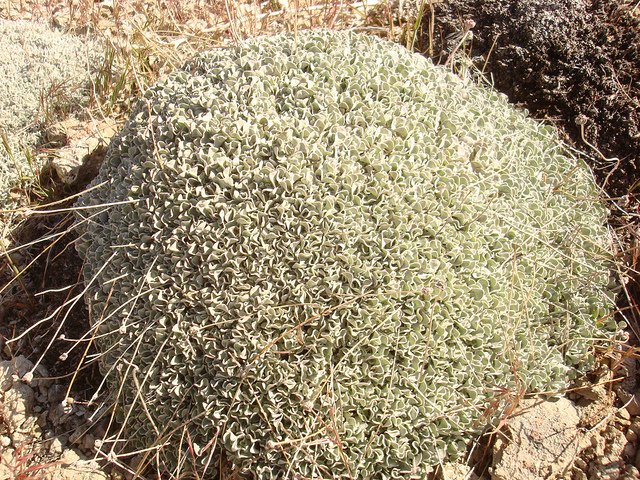This variety of E. ovalifolium is on the endangered species list due to its very limited range. I am lucky that I live very near it's specific habitat. It grows on geothermally derived soils found just south of Reno at the Steamboat Hotsprings. It's total range encompasses about 150 acers on public and private land.
Here are links that give more information about this rare Eriogonum.
http://www.centerforplantconservation.org/collection/cpc_viewprofile.asp...
http://www.centerforplantconservation.org/collection/NationalCollection....
http://heritage.nv.gov/reports/erovwbro.pdf
http://www.amjbot.org/cgi/content/abstract/88/4/608
http://calphotos.berkeley.edu/cgi/img_query?stat=BROWSE&query_src=photos...
The last picture in this set is of Eriogonum ovalifolium var. williamsiae intertwined with Astragalus newberryi in native habitat






Comments
Mark McDonough
Re: Eriogonum ovalifolium var. williamsiae
Thu, 11/11/2010 - 6:48pmJohn, that's one impressive buckwheat :o, the foliage is amazing, worth growing (if it is growable) for the foliage alone. Good informative links too. I'd like to have it growing in my garden, intertwined with a gorgeous locoweed! Do you know of anyone growing this, perhaps some botanical institutions?
John P. Weiser
Re: Eriogonum ovalifolium var. williamsiae
Fri, 11/12/2010 - 9:31amI am sorry to say that I do not know of anyone growing this variety. There are stringent guide lines to meet in order to collect any part of this plant on public or protected private land. I have not contacted the state forestry office to inquire about collection requirements or permits for personal use.
There is one small area that I feel is on unprotected private land but I have not gone to the trouble of researching it's status or if it is possible to legally collect there with just the permission of the owner.
I agree that It would be a wonderful plant. The doming nature of the older plants is outstanding. The larger plants can be up to 10 inches across and 6-8 inches tall at the center. They are very dense and tightly packed. When you place your hand on them and press down they do not give at all.
In habitat you will find many old clumps that have died back but still have a clump of branches peeking out, that are still alive. It is a uniquely charming sight to see a dome that has died back around the edges but is still vigorously growing in the center. The dead portions persist for years. I know of several plants that have recovered so much so that they are layering new fresh growth over the desiccated dead portions.
Trond Hoy
Re: Eriogonum ovalifolium var. williamsiae
Tue, 11/16/2010 - 1:19pmWhy are so beautiful plants called buckwheat? I can't detect any similarities with buckwheat (Fagopyrum esculentum)!
John P. Weiser
Re: Eriogonum ovalifolium var. williamsiae
Tue, 11/16/2010 - 2:12pmHoy
Family connections I guess! ::)
They both belong to the family Polygonaceae.
Trond Hoy
Re: Eriogonum ovalifolium var. williamsiae
Wed, 11/17/2010 - 12:21pmYes, I know; and you are probably right!
However, I know many plants from this family more similar to Fagopyrum than Eriogonum are, and they are not called buckwheat!
John P. Weiser
Re: Eriogonum ovalifolium var. williamsiae
Wed, 11/17/2010 - 2:50pmYa I know what you are getting at. I guess I have no good answer to your question! :-\
Many common names make no sense, even to us native English speakers. ;)
Anne Spiegel
Re: Eriogonum ovalifolium var. williamsiae
Thu, 11/18/2010 - 4:59amThis is a sensational eriogonum in every respect except perhaps ease of culture, and apparently no one can answer that question. I really need to find out more about Astragalus argophyllus v argophyllus, equally sensational and now on my "would like to grow" list. Thanks for the wonderful pictures.